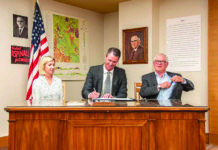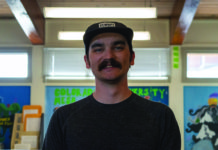by Bryce Reedy
The Colorado Bureau of Investigation’s (CBI) home office for the northwest corner of the state is located in Grand Junction and is home to one of only three virtual reality simulators in the state.
The other two are located in Colorado Springs and Denver.
These virtual reality simulators are some of the newest training methods that police officers are using across the country. Departments are trying to get away from the Fire Arms Training Simulator (FATS) and move towards new and improved virtual reality simulators. The FATS system is a single screen system that has been around for over 20 years.
“The problem with (the FATS system) is it’s a single screen unit and is unrealistic,” Agent in Charge Collin Reese said. “In the real world, you should be looking all around you.”
“I have been in law enforcement for over 20 years,” Director of Campus Safety and Student Conduct at CMU Pua Utu said. “and when we first started hearing about FATs training […] you are playing the scenario, but you are now being blindfolded […] so it misses part of what you learn as a rookie cop or a cadet from the academy.”
Unlike the FATS system, the virtual reality simulators offer 300 degrees around the individual training, which allows for more realistic scenarios for agents and officers.
“We have had great reviews especially because of the 300 degrees,” Agent John Zamora said.
Zamora is the agent, who runs the VR system and teaches the officers, who go through the stimulation.
The system also includes surround sound to make the situations as realistic as possible. Noises such as dogs, car horns, gunshots and people screaming are just some of the sounds that an individual will hear when partaking in the simulation.
Reese and Zamora were nice enough to let me experience the simulation first-hand and I ran through a couple of scenarios. They knew that I did not have any background in law enforcement, but they wanted to give me the opportunity to run the simulation for myself to see what police officers go through on an individual day.
To begin the simulator I was given an airsoft gun attached with a wire that went to a metal sensor. Reese and Zamora told me to put the gun in my front pocket and the sensor in my back pocket.
The first scenario they ran me through was a call-in about an ex-girlfriend yelling at her ex-boyfriend and his current girlfriend. When I arrived on the scene it looked to be a screaming match between the three people, but then without any warning, the ex-girlfriend pulled a gun and started shooting.
At the beginning of the scenario I went in assuming that I was just going to have to talk the situation down, but when the gun was pulled I started to panic.
So I pulled my gun and told the woman to get out of the car. She threw the gun out the car window and came out to start yelling at me.
That was when she got on the ground. However, I did not notice she was staring at the gun the entire time while talking to me. So while I was trying to figure out what to do next she already knew where she was going.

She grabbed the gun and fired at me. I was stunned. I did not even pull the trigger because I did not see it coming.
That one scenario lasted about two minutes, but I only had split seconds to react about what I had to do next. After I was shot, the simulation stopped and Reese and Zamora went back through the entire sequence with me to show where I messed up and how someone, who has a law enforcement background would have gone through it.
While I knew that it was just a simulation, it felt real with all of the sounds and visuals that I was processing all at once, and it illustrated what it is like as an officer going into a situation where you know little, but have to be ready for just about anything.
I got a second chance. They sent me into the simulation again. This time I was sent to a park where a mentally handicapped individual was throwing objects at kids in a park while he had a dog that was out of control and constantly parking.
This time going into the scene I had a better idea of what I needed to say and do, including how to shoot the pistol. When I got to the individual I tried to talk to him and calm him down.
Communication was the most important concept that I learned throughout this process, which Reese and Zamora stressed. They kept bringing up the idea that if you are not communicating then people who are watching the situation may not know what is going on, so if an officer does have to fire his weapon then the witnesses may say that the officer had no right to do that because he was not communicating with anyone on the scene.
However, this individual was not in a real state of mind. He called me “the evil one” and was saying that “[I] was there to take [his] stuff.” I tried to calm him down, but then he pulled a machete off the table and said he was going to come at me. This time, unlike the first, I was able to convince him to throw the machete away and made sure he was not going to go anywhere near it.
But, I did not account for him releasing the dog on me. So when he let him go I had to run out of the way to avoid it. That was where the simulation ended, and Zamora went into more detail of the places that I was incorrect in my actions.
By being able to use the simulator it illustrated to me how quickly things can change for law enforcement in the field. It also showed me that officers have to be constantly checking their surrounds and aware of everything at all times.
When the dog attacked I knew that I had to get out of the way, but Zamora showed me that I forgot about the kids who were behind me who would have been attacked because of the fact that I moved out of the way.
Along with the system’s setup, the virtual reality also offers a variety of different situations for the officers and to train on. Some of the situations include school shootings, inmate breakouts and basic everyday calls that police officers receive. The more situations that the system has to offer, the more prepared officers will be when they come out.
“That is the benefit about these simulators because you can kind of twist the training to fit your environment,” Utu said. “[…] It is a different environment and a different type of policing as well. So there are some scenarios at the simulator that we can actually put ourselves through and adjust so that we can work on our tactic.”
Another one of the applications that this simulator offers is the ability to change what is happening within a particular simulation based on how the individual communicates with a situation. With the multitude of scenarios to go through, it gives the officers as close to real life situations as possible. The simulator is a key learning tool when it comes to training to become an officer.
“The beauty of this is that you learn,” Zamora said. “A lot of it is verbal communication. Being loud and clear.”
“That is the awesome thing about the machine,” Utu said. “It gives you that option on a preset environment where you can train to shoot at the same time working on your skills [such as] accuracy, marksmanship at the same time you are working on your tactic and how you can dissect a room this big versus a hall versus an active shooter.”
Following the completion of the simulation, the program allows for the officers to go back through the situation they just experienced in slow motion to go over where mistakes were made and what should have happened instead.
Due to the advantages that the virtual reality system gives, organizations like federal agencies, local law enforcement and state agencies come to the CBI to use the system. Along with those organizations, CMU would also take their campus police there to train on the system.
“When I was with the Grand Junction police department I usually [took] my team that were assigned to the campus to use that,” Utu said.
Reese said organizations have seen a vast improvement with their officers and cadets who have used this program.



